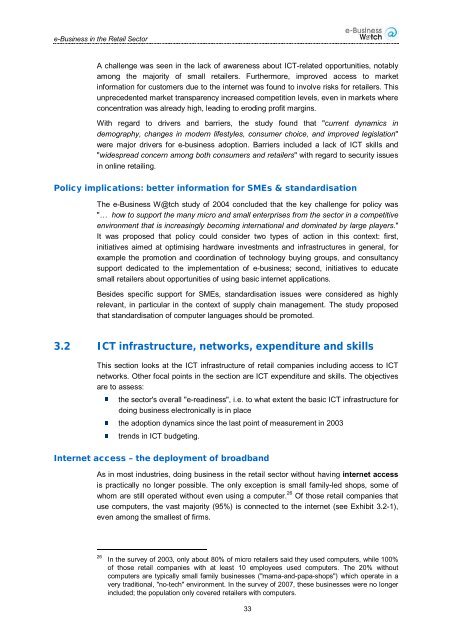ICT and e-Business Impact in the Retail Industry - empirica
ICT and e-Business Impact in the Retail Industry - empirica
ICT and e-Business Impact in the Retail Industry - empirica
- No tags were found...
Create successful ePaper yourself
Turn your PDF publications into a flip-book with our unique Google optimized e-Paper software.
e-<strong>Bus<strong>in</strong>ess</strong> <strong>in</strong> <strong>the</strong> <strong>Retail</strong> SectorA challenge was seen <strong>in</strong> <strong>the</strong> lack of awareness about <strong>ICT</strong>-related opportunities, notablyamong <strong>the</strong> majority of small retailers. Fur<strong>the</strong>rmore, improved access to market<strong>in</strong>formation for customers due to <strong>the</strong> <strong>in</strong>ternet was found to <strong>in</strong>volve risks for retailers. Thisunprecedented market transparency <strong>in</strong>creased competition levels, even <strong>in</strong> markets whereconcentration was already high, lead<strong>in</strong>g to erod<strong>in</strong>g profit marg<strong>in</strong>s.With regard to drivers <strong>and</strong> barriers, <strong>the</strong> study found that "current dynamics <strong>in</strong>demography, changes <strong>in</strong> modern lifestyles, consumer choice, <strong>and</strong> improved legislation"were major drivers for e-bus<strong>in</strong>ess adoption. Barriers <strong>in</strong>cluded a lack of <strong>ICT</strong> skills <strong>and</strong>"widespread concern among both consumers <strong>and</strong> retailers" with regard to security issues<strong>in</strong> onl<strong>in</strong>e retail<strong>in</strong>g.Policy implications: better <strong>in</strong>formation for SMEs & st<strong>and</strong>ardisationThe e-<strong>Bus<strong>in</strong>ess</strong> W@tch study of 2004 concluded that <strong>the</strong> key challenge for policy was"… how to support <strong>the</strong> many micro <strong>and</strong> small enterprises from <strong>the</strong> sector <strong>in</strong> a competitiveenvironment that is <strong>in</strong>creas<strong>in</strong>gly becom<strong>in</strong>g <strong>in</strong>ternational <strong>and</strong> dom<strong>in</strong>ated by large players."It was proposed that policy could consider two types of action <strong>in</strong> this context: first,<strong>in</strong>itiatives aimed at optimis<strong>in</strong>g hardware <strong>in</strong>vestments <strong>and</strong> <strong>in</strong>frastructures <strong>in</strong> general, forexample <strong>the</strong> promotion <strong>and</strong> coord<strong>in</strong>ation of technology buy<strong>in</strong>g groups, <strong>and</strong> consultancysupport dedicated to <strong>the</strong> implementation of e-bus<strong>in</strong>ess; second, <strong>in</strong>itiatives to educatesmall retailers about opportunities of us<strong>in</strong>g basic <strong>in</strong>ternet applications.Besides specific support for SMEs, st<strong>and</strong>ardisation issues were considered as highlyrelevant, <strong>in</strong> particular <strong>in</strong> <strong>the</strong> context of supply cha<strong>in</strong> management. The study proposedthat st<strong>and</strong>ardisation of computer languages should be promoted.3.2 <strong>ICT</strong> <strong>in</strong>frastructure, networks, expenditure <strong>and</strong> skillsThis section looks at <strong>the</strong> <strong>ICT</strong> <strong>in</strong>frastructure of retail companies <strong>in</strong>clud<strong>in</strong>g access to <strong>ICT</strong>networks. O<strong>the</strong>r focal po<strong>in</strong>ts <strong>in</strong> <strong>the</strong> section are <strong>ICT</strong> expenditure <strong>and</strong> skills. The objectivesare to assess:<strong>the</strong> sector's overall "e-read<strong>in</strong>ess", i.e. to what extent <strong>the</strong> basic <strong>ICT</strong> <strong>in</strong>frastructure fordo<strong>in</strong>g bus<strong>in</strong>ess electronically is <strong>in</strong> place<strong>the</strong> adoption dynamics s<strong>in</strong>ce <strong>the</strong> last po<strong>in</strong>t of measurement <strong>in</strong> 2003trends <strong>in</strong> <strong>ICT</strong> budget<strong>in</strong>g.Internet access – <strong>the</strong> deployment of broadb<strong>and</strong>As <strong>in</strong> most <strong>in</strong>dustries, do<strong>in</strong>g bus<strong>in</strong>ess <strong>in</strong> <strong>the</strong> retail sector without hav<strong>in</strong>g <strong>in</strong>ternet accessis practically no longer possible. The only exception is small family-led shops, some ofwhom are still operated without even us<strong>in</strong>g a computer. 26 Of those retail companies thatuse computers, <strong>the</strong> vast majority (95%) is connected to <strong>the</strong> <strong>in</strong>ternet (see Exhibit 3.2-1),even among <strong>the</strong> smallest of firms.26In <strong>the</strong> survey of 2003, only about 80% of micro retailers said <strong>the</strong>y used computers, while 100%of those retail companies with at least 10 employees used computers. The 20% withoutcomputers are typically small family bus<strong>in</strong>esses ("mama-<strong>and</strong>-papa-shops") which operate <strong>in</strong> avery traditional, "no-tech" environment. In <strong>the</strong> survey of 2007, <strong>the</strong>se bus<strong>in</strong>esses were no longer<strong>in</strong>cluded; <strong>the</strong> population only covered retailers with computers.33
















